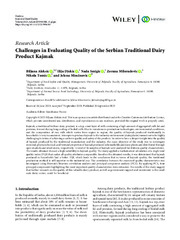Приказ основних података о документу
Challenges in Evaluating Quality of the Serbian Traditional Dairy Product Kajmak
| dc.creator | Aleksic, Biljana | |
| dc.creator | Djekic, Ilija | |
| dc.creator | Smigic, Nada | |
| dc.creator | Miloradovic, Zorana | |
| dc.creator | Tomic, Nikola | |
| dc.creator | Miocinovic, Jelena | |
| dc.date.accessioned | 2023-11-22T13:33:45Z | |
| dc.date.available | 2023-11-22T13:33:45Z | |
| dc.date.issued | 2023 | |
| dc.identifier.issn | 0146-9428 | |
| dc.identifier.uri | http://aspace.agrif.bg.ac.rs/handle/123456789/6483 | |
| dc.description.abstract | Kajmak, a traditional Serbian dairy product, is a top, crust layer of milk containing a high amount of aggregated milk fat and proteins, formed during long cooling of boiled milk. Due to variations in production technologies, environmental conditions, and the composition of raw milk which varies from region to region, the quality of kajmak produced traditionally in households is very inconsistent. Attempts to produce kajmak in the industry environment (dairy plants) turned out to be highly challenging in terms of achieving a uniform quality and safety of the product. In order to have a deeper insight into the quality of kajmak produced by the traditional manufacture and the industry, the main objective of the study was to investigate sensorial, physicochemical, and textural properties of kajmak produced in households and dairy plants and distributed through open markets and retail stores, respectively. A total of 36 samples of kajmak were analyzed for thirteen quality characteristics. The results obtained showed a high variability in kajmak quality. The study applied a mathematical calculation of a single total quality index (TQI) that makes all quality attributes comparable. Based on the obtained results, it was determined that kajmak produced in households had a better TQI, which leads to the conclusion that in terms of kajmak quality, the traditional production method is still superior to the industrial one. The correlation between the examined quality characteristics was investigated using Pearson's bivariate correlation analysis and principal component analysis (PCA). By applying PCA, four principal components highlighting the most important quality characteristics were extracted. The results of the study suggest that further research on the quality of this valuable dairy product, as well as government support and investment in the small scale dairy sector, could be beneficial. © 2023 Biljana Aleksic et al. | |
| dc.language | English | |
| dc.rights | openAccess | |
| dc.rights.uri | https://creativecommons.org/licenses/by/4.0/ | |
| dc.source | Journal of Food Quality | |
| dc.source | Journal of Food Quality | |
| dc.title | Challenges in Evaluating Quality of the Serbian Traditional Dairy Product Kajmak | |
| dc.type | article | en |
| dc.rights.license | BY | |
| dc.citation.rank | M22~ | |
| dc.citation.volume | 2023 | |
| dc.identifier.doi | 10.1155/2023/9996340 | |
| dc.identifier.fulltext | http://aspace.agrif.bg.ac.rs/bitstream/id/24956/Challenges_in_Evaluating_pub_2023.pdf | |
| dc.type.version | publishedVersion |


